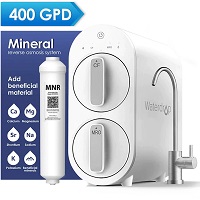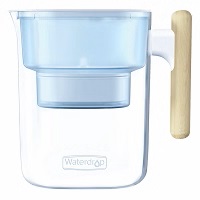Wells have become essential components of our societies. When and where surface water is scarce, people resort to wells as an excellent water supply for domestic, agricultural, and industrial applications. Interestingly, over 13,000,000 American households have a private well and rely on well water as a major water source.
What Is Well Water?
Wells are privately-owned – the water from these wells is called well water. It is a form of groundwater, considering it comes directly from the earth. Obtaining well water involves drilling a hole into the permeable rock layer with groundwater in it. Then, the water produced is carried into the home (or other places) using a pump. Unlike tap water, well water is not under the Environmental Protection Agency (EPA) regulation. Instead, it is privately managed by the homeowners.
Well water is often hard, and the hardness is due to different minerals present in the ground. Leaving the hardness untreated affects the taste and smell of the well water differently. While it is safe to use and drink well water, drinking it may affect your lifestyle.
Advantages And Disadvantages Of Well Water
Well water is not perfect – it has a few upsides and downsides. It is best to learn about these before having a private well for your home.
Let's start with the advantages.
Why should you have a well?
Owning a well comes with convenience, or even more convenience for people living on city outskirts. But that’s not all.
You can stop paying water bills.
Wells are privately owned, so you have zero water bills coming in at the end of the month. It is a cost-effective way to provide water for your household.
Unlimited supply of clean water.
Disruptions to municipal water supply systems are not uncommon. They may be due to natural disasters or other reasons. However, these do not affect well water. You can enjoy a constant uncontaminated water supply for 30-50 years with a well.
Enjoy cleaner and fresher water.
Well water comes directly from the aquifer; therefore, it is cleaner and fresher than tap water. Trace minerals also make it great tasting and beneficial to our health.
Why should you not have a well?
Let’s look at the reasons you should not consider having a well.
You now have more responsibilities.
A privately owned well is privately maintained. You will spend more maintaining a well, from regular testing to standard maintenance practices to ensure safety.
Well water is hard water.
The dissolved minerals in well water make it hard. It requires a softening system to soften it, except there are little or no natural minerals in your area. Acquiring a water softener for water treatment means additional cost.
There are contamination risks.
Well water is exposed to multiple potential contaminants, including dead animals, bacteria, heavy metals, and chemicals. That is why it is inadvisable to drink well water directly without purification.
Common Well Water Pollutants And How They Affect Consumers
Almost all water sources are susceptible to contaminants. The EPA adopts standard water treatment processes to purify municipal water supply systems. Since well water is privately owned, this responsibility falls on the owner. Read on to learn the potential water contaminants and their impacts.
Microorganisms
Waste and sewage contain parasites, viruses, and bacteria. These microorganisms can be washed into the waterbed by water run-off from snow-melt and rainfall. The direct consumption of this microorganism-containing water causes gastrointestinal diseases and infections in humans.
Heavy metals
When present in the body in high amounts, heavy metals can damage the kidney, liver, and intestines. Only certain purification processes can remove selenium, lead, copper, chromium, cadmium, antimony, and arsenic from well water. These metals can also cause acute anemia and cancer.
Nitrites and nitrates
Nitrates and nitrites come from animal waste, human sewage, and chemical fertilizers. In addition, activities like water run-offs, surface water seepages, and groundwater movements can contaminate well water with excessive amounts of nitrite and nitrate. Common resulting illnesses include blue baby syndrome and methemoglobinemia.
Organic chemicals
Organic chemicals are important components in the agricultural and manufacturing industries. Therefore, they are potential pollutants of well water, especially through surface water run-off, spills, and waste disposal. If present in excess amounts, these chemicals can harm vital body organs.
Radionuclides
Nuclear activities like nuclear power production, coal mining, uranium milling, and milling all lead to the release of radionuclides. These radionuclides are proven well water contaminants through flooding, seepage of wastewater, and groundwater flow. Drinking this contaminated water exposes the body to kidney issues and cancer.
Fluoride
The body needs fluoride to prevent tooth decay. However, when present in excessive amounts, fluoride leads to skeletal fluorosis. It is also the leading cause of teeth pitting, tooth discoloration, and dental fluorosis, especially when consumed in high amounts during the formation of tooth enamel.
How Do You Prevent Well Water Pollution?
Protecting your well water from contamination starts with properly managing activities around the water source. For instance, if you have a domestic well, you should ensure contaminants do not get close to sinkholes and the well itself. Also, do not bring hazardous chemicals close to septic systems. Here are a few practical tips to ensure these:
- Divert the surface run-off water away from the well by sloping the area around the well.
- Do not use or mix your fertilizers, pesticides, and similar chemicals close to the well.
- Protect the well from unauthorized use by installing a sanitary seal or well cap.
- Keep track of the well maintenance schedules involving the use of chemicals.
- Ensure waste pesticides, solvents, or harsh chemicals do not end up in the septic system or dry well.
- Monitor the exposed parts of the well regularly to spot problems early.
- Never dispose of household wastes in abandoned or dry wells.
- Consult your local environmental agency or health department to ensure industrial activities around you happens at a safe distance from your well.
How Do You Treat Well Water?
We have mentioned how well water can be potentially contaminated. Fortunately, you can ensure your well water is of the best quality and safe for drinking by adopting a suitable treatment method. There are four popular methods of well water treatment.
Boiling
Boiling is the safest and cheapest of all the well water purification methods. Germs and parasites in well water are invisible to the naked eye. However, they can be dangerous if they end up in the body system. So, boil your well water, allowing it to roll-boil for about three minutes, and finally cool before drinking.
Disinfection
When you disinfect water, you remove, kill, or inactivate the pathogenic microorganisms present. Disinfectants can be physical or chemical. Physical disinfectants are heat, electronic radiation, and ultraviolet light, while chemical disinfectants include ozone, chlorine dioxide, and chlorine. When microorganisms in the water are inactivated chemically or physically, they cease to grow or reproduce, making them incapable of harming the consumer.
Water softeners
Water softeners are designed to eliminate minerals and odors present in well water. These devices are equipped with resin beads, which trap calcium and magnesium ions. It further replaces the trapped ions in the filled resin beads with potassium or sodium ions.
Water filtration
Water filtration is an efficient method of removing or reducing the concentration of fungi, algae, parasites, viruses, bacteria, suspended particles, and other particulate matter in well water. It is also effective against other biological contaminants and chemicals often found in contaminated water.
Best Purification Methods For Well Water
Well water may contain a great amount of large to small impurities that are harmful for your body and might damage other home appliances. It should be noted that a whole house pre-filtration system is a must if you take well water as the main source of water. The whole house pre-filtration system is designed to trap impurities and keep them from reaching your home’s water supply and reduce the workload of other water filters.
Learn more about the whole house pre-filtration system.
Waterdrop G2 RO System
Like other RO systems, the Waterdrop G2 RO System uses the reverse osmosis effect to filter well water. When subjected to a certain voltage, the source compartment of the RO membrane forms a pressure difference on both sides of the membrane. This difference facilitates the passage of water molecules while trapping contaminants and heavy metals.
The Waterdrop G2 tankless RO system runs on a composite filtration system that effectively reduces the most harmful contaminants in water. This device’s >90% TDS reduction rate is impressive, providing RO mineral water immediately on request. You and your family can enjoy safe drinking water directly from the source.
Waterdrop Chubby Water Filter Pitcher
The Waterdrop Chubby Pitcher is another excellent option for well water purification. With NSF 372 and 42 certifications, it is made from safe materials and can effectively reduce bad odor, taste, and chlorine. It runs on a multi-stage filtration technology that delivers pure water free of fluoride, arsenic, and other contaminants. In addition, there is a smart LED filter life indicator that helps you keep track of water quality in real-time.
Conclusion
Considering wells are privately owned, it is your responsibility to ensure your well water is safe and healthy for consumption. Testing periodically and having a whole household water filtration system in place can help you fulfill this responsibility. Remember, your family deserves the freshest and healthiest drinking water.





